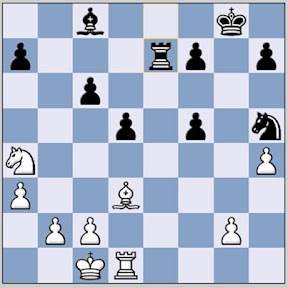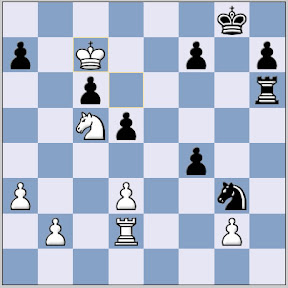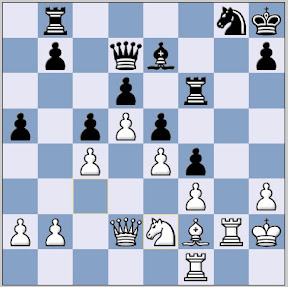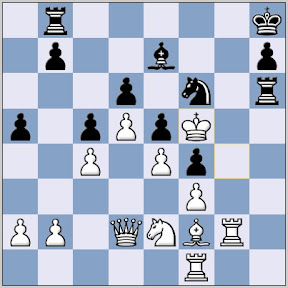In this post, I've got an illustration of both. They are from two of the best games in chess history. The first sees Mikhail Tal strolling up the board, sacrificing two pawns in the process, to set up a winning ending. The second is a spectacular king hunt by Alexander Kotov; the most beautiful game played at the famous Zurich 1953 Candidates Tournament.
 This is the postion after 24 moves in Tal vs. Lisitsin, Leningrad 1956 (Game no.2 in Chernev's "The Most Instructive Games of Chess Ever Played
This is the postion after 24 moves in Tal vs. Lisitsin, Leningrad 1956 (Game no.2 in Chernev's "The Most Instructive Games of Chess Ever Played25 Kd2! Ng3; 26 Kc3 f4; 27 Kd4 Bf5; 28 Rd2 Re6; 29 Nc5 Rh6; 30 Ke5! Bxd3; 31 cd Rxh3; 32 Kd6 Rh3+; 33 Kc7
 In just 8 moves Tal's king has gone from c1-c7 and he has sacrificed a second pawn. However, he now uses the active position of his king to force a won rook ending:
In just 8 moves Tal's king has gone from c1-c7 and he has sacrificed a second pawn. However, he now uses the active position of his king to force a won rook ending:33 ... Nf5; 34 Kb7 Nd4; 35 Rf2 a5; 36 Rxf5 Ne6; 37 Rg4+ Kf8; 38 Kxc6 Nxc5+; 39 Kxc5 Re6; 40 Kxd5
Tal is clearly better in this rook ending; it's instructive to follow his technique in concluding the game:
40 ... Rb6; 41 b4 ab; 42 ab Ke7; 43 Kc5 Rf6; 44 Rd4 Rf5+; 45 Kb6 Rf6+; 46 Kc7 Rf5; 47 Re4+ Kf6; 48 Kc6 Rf2; 49 g4 h5; 50 gh Kg5; 51 b5 f5; 52 Rb4 f4; 53 b6 f3; 54 b7 1-0
The next game, Averbakh - Kotov Zurich 1953 was greeted with quotes such as "unique in chess literature" and "once in a hundred years". This is what Bronstein had to say about the position after White's 30th move:

"The creative element of chess is generally thought to consist of three things: logic, accurate calculation, and technuique (this last includes a knowledge of theory). There is a fourth ingredient also, however, perhaps the most intriguing of all, although it is often overlooked. I refer to intuition - chess fantasy, if you prefer.
Occasionally a position arises in the course of a game which cannot be evaluated on general principles, such as pawn weaknesses, open lines, better development, etc., since the state of equilibrium has been upset on several counts, rendering an exact weighing of the elements impossible. Attempting to calculate the variations doesn't always work, either. Imagine that White has six or seven different continuations, and Black five or six replies to each move; it's easy to see that no genius on earth could reach even the fourth move in his calculations. It is then that intuition or fantasy comes to the rescue: that's what has given the art of ches its most beautiful combinations, and allowed chessplayers the chance to experience the joy of creating.
It is not true to say that intuitive games were only played in the days of Morphy, Anderssen and Chigorin (as if now, in our era, everything were to be based totally on positional principles and rigorous calculation!): I remain convinced that, even in the games which received the brilliancy prizes at this tournament, not all of the variations were calculated to the end. Intuition has been and remains one of the cornerstones of chess creativity - of which we shall now see proof positive." David Bronstein, International Chess Tournament: Zurich 1953
Kotov began a remarkable combination by sacrificing his queen:
30 ... Qxh3+; 31 Kxh3 Rh6+; 32 Kg4 Nf6+; 33 Kf5
 The king has been driven into the net of Black's remaining pieces, and now 33 ... Ng4! would have finished the game quickly. Although, after the move Kotov played, 33 ... Nd7, White despite his extra Queen was still unable to defend the position.
The king has been driven into the net of Black's remaining pieces, and now 33 ... Ng4! would have finished the game quickly. Although, after the move Kotov played, 33 ... Nd7, White despite his extra Queen was still unable to defend the position.You can play through the full games Tal vs Lisitsin and Averbakh vs Kotov online.

2 comments:
Nice examples. It's a remarkable sight to see his majesty so far from home!
Another game that could be added was the following, where Nigel Short marches his King up the board to finish off Jan Timman. Beautiful!
[Result "1-0"]
[White "Nigel Short"]
[Black "Jan Timman"]
1.e4 Nf6 2.e5 Nd5 3.d4 d6 4.Nf3 g6 5.Bc4 Nb6 6.Bb3 Bg7 7.Qe2
Nc6 8.O-O O-O 9.h3 a5 10.a4 dxe5 11.dxe5 Nd4 12.Nxd4 Qxd4
13.Re1 e6 14.Nd2 Nd5 15.Nf3 Qc5 16.Qe4 Qb4 17.Bc4 Nb6 18.b3
Nxc4 19.bxc4 Re8 20.Rd1 Qc5 21.Qh4 b6 22.Be3 Qc6 23.Bh6 Bh8
24.Rd8 Bb7 25.Rad1 Bg7 26.R8d7 Rf8 27.Bxg7 Kxg7 28.R1d4 Rae8
29.Qf6+ Kg8 30.h4 h5 31.Kh2 Rc8 32.Kg3 Rce8 33.Kf4 Bc8 34.Kg5
1-0
It's a small world...
... I exchanged some email with Nigel Short today about this very game...
... I'll cover it in a blog post in the next few days.
I'd mentioned it briefly in a previous post about heroic chess failures.
Post a Comment